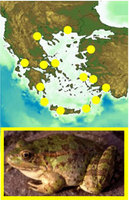A recent article in Science suggests that the number of whales before hunting started was much larger than anyone has suspected. These controversial results originated from calculations on genetic variation among today's whales. Peter Beerli at SCS developed the method and the computer tool used in the study.
It all started with substantially smaller animals, though. When Peter Beerli, now an FSU professor, was a PhD student in Switzerland he used water frogs (Rana esculenta group) as models in his evolutionary studies. The Greek archipelago provided him with the ideal material. The frogs on the different islands descended from a common ancestor, but had been isolated from their relatives on other islands for about five million years, separated by the saltwater barrier. And once they were cut off, the frogs on each island began to vary from their neighbors because of the genetic mutation "clock" that always ticks at a slow, but predictable, rate.
Most mutations are minor and harmless, and might not even create any obvious external difference in the organism. They do, however, drift into the common gene pool of a population where they provide scientists with an important historic record. With the right computational methods, it is possible to peer into the past by analyzing the genetic variations of today.
At the time Peter Beerli began his studies, there were simple techniques available to compare the genetic variation between any two, isolated populations. But when he also wanted to take into account the migration rates between different populations on the Greek and Turkish mainland, he got stuck. There was simply no method that allowed him to look at all populations at the same time. The pairwise approach, that he was able to use for the isolated populations, was not good enough when frogs from different populations were able to mingle. Peter Beerli had to develop new techniques and incorporate them in a computer program. His program, named MIGRATE, now allows scientists to estimate migration rates, as well as present and historic population sizes, using genetic data.
In the journal Science of July 2003, two other scientists described how they used MIGRATE to calculate historic population sizes of North Atlantic whales. Analyzing the genetic variation of today\'s whales, together with additional information on average generation time and breeding age, they got surprising results. They found that populations of humpback and fin whales before whaling were about ten times greater than previously thought. If the results are correct, then the current populations are a long way from recovery and conservation strategies need to be much more extensive. The analyses involve some assumptions that can be scientifically disputed, but still it is the first attempt to assess the former whale populations based on an objective method rather than counts from old whalers' logbooks.
That debate will go on for a length of time. Meanwhile, Peter Beerli continues to refine MIGRATE. Originally programmed for desktop computers, where an individual run of a big dataset would take weeks, the program has now been rewritten (parallelized) to run many times faster on the SCS Supercomputers and on computer clusters. Faster calculations make it possible to use much larger datasets than before, thus getting more reliable results. Biologists across the globe now use MIGRATE to find clues on evolution and ecology hidden in the DNA of birds, insects, fish and humans.


